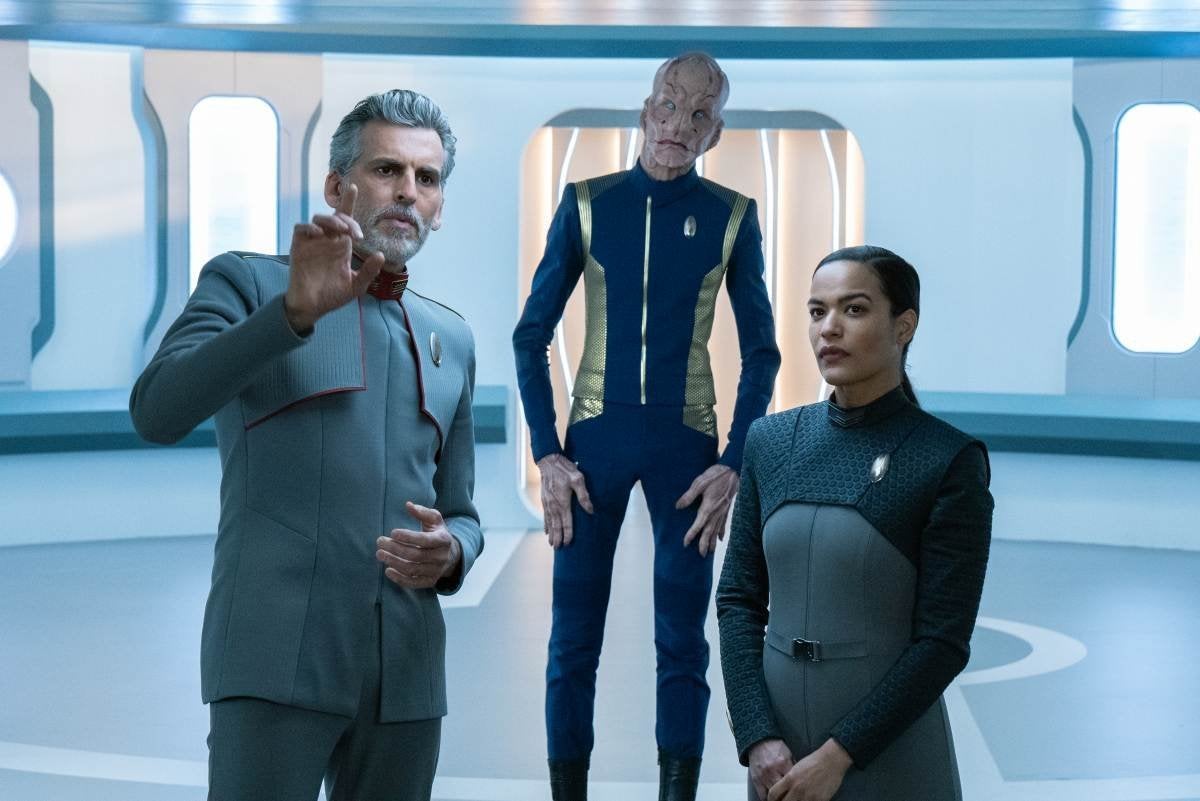This Star Trek: Discovery article contains spoilers for Season 3, Episode 5, “Die Trying.”
After four episodes of searching for what was left of the United Federation of Planets, the crew of the USS Discovery actually finds the new incarnation of their government, 930 years later. For a casual fan, the new Starfleet and United Federation of Planets may not seem all that different — after all, didn’t they have greyish uniforms kind of like that in the last Chris Pine movie, Star Trek Beyond? Superficially, Starfleet may have been given a sleek upgrade, but the look and feel of the most famous fictional space-faring organization isn’t actually the big news. Yes, we got a good look at a new (or old?) USS Voyager as well as several other shiny starships from the 32nd Century. But, the bigger changes fundamentally alter the context of what Star Trek is all about. Here are three ways Discovery has altered what Starfleet and the Federation are all about…
Federation and Starfleet are apparently now the same thing.
In two separate instances in “Die Trying,” it’s established that the “civilian government” of the United Federation of Planets and the pseudo-military organization of Starfleet have essentially combined. Admiral Vance (Oded Fehr) tells Saru and Burnham that this has been the case since The Burn. Earlier in the episode, Saru reminds us in his Captain’s log that Starfleet and the Federation are “separate entities that now must abide together.”
But what does this actually mean? Well, because we only see Starfleet officers deciding what goes and what everyone is supposed to be doing with their time, it’s possible to assume that Starfleet has kind of taken over the decision-making process of the Federation. That said because Vance admits that it’s pretty difficult to keep in touch with other Federation planets because of all the problems with subspace relays being knocked out, it’s possible you could have entire pockets of the Federation being governed and behaving entirely different than the “real” Federation that we see. In other words, although we’re told that this is the “real” Federation and Starfleet and that this is their Headquarters, this actually just represents a consensus of aspects of the Federation that could stay in touch.
Starfleet running the Federation is a nightmare situation David Marcus and Captain Sisko wanted to avoid.
In Star Trek II: The Wrath of Khan, Kirk’s son, David Marcus, points out that “scientists have always been pawns of the military.” Carol Marcus insists that “Starfleet has kept the peace,” but the idea that Starfleet would – and could — easily seize power over its civilian entities has always been an ethical conundrum throughout most iterations of the franchise. In the Deep Space Nine episodes “Homefront” and “Paradise Lost,” Sisko and Odo work to prevent Starfleet from declaring martial law on Earth. Granted, in that scenario there was a legit conspiracy at work, but, in some senses, Discovery has presented a version of Starfleet that is the literal manifestation of interstellar law, regardless of whether that power has been “earned.”
The age of exploration is over.
Vance tells Saru and Burnham that “we don’t have five-year missions anymore” and claims this is because Starfleet is all about doing other stuff. This kind of echoes a complaint from Jean-Luc Picard in the movie Star Trek: Insurrection when he said: “Can anyone remember when we used to be explorers?” The larger point is that Starfleet is 100 percent focused on putting out fires and keeping the peace on whatever worlds they claim are under Federation protection. Part of their biggest concern is a kind of space mafia known as the Emerald Chain, which seems to be an outgrowth of the Orion-Andorian syndicate glimpsed in “That Hope Is You, Part 1.”
So, Starfleet/Federation is mostly dealing with fighting off a big space mob, which seems to be hell-bent on expanding its sphere of influence across a bunch of Federation planets. This means that Starfleet’s less-than-nice approach to running things makes a certain amount of sense. In some ways, the new Starfleet has more in common with the Resistance in the Star Wars sequel films than with the Starfleet of old. They’re not exactly a government, but they really want to create a galaxy in which a better government is possible.
Is there another Federation?
The last piece of this puzzle is arguably the Short Treks episode “Calypso.” In that episode — possibly set in the same time period as Discovery Season 3 — we learn that the people of Alcor IV are at war with the “V’draysh.” This season of Discovery has established that “V’draysh” is a pidgin word for “Federation.” So, why is some aspect of the Federation at war with anyone in this future? (Or even further in the future?)
Maybe, the Federation we have met in Discovery Season 3 is, as stated, just a collection of ships and planets that have managed to stay in touch. Perhaps, there are other Federations out there, totally out of contact with this one. And if that’s the case, then they might have a totally separate set of rules than the new Starfleet we’ve met. If this were a Star Wars problem, you’d be tempted to wonder if that means more good guys or more bad guys. But, because this is Star Trek, the answer will probably be both. And neither.
Star Trek: Discovery is streaming now on CBS All Access.
